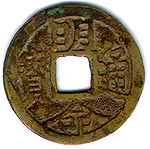|
Thien Bing Hung Bao
This coin was minted between 970 and 979. It is the first coin in the
official series of Annamese dynastic coins. The Hung character of this
coin is very unorthodox. On the reverse side above the hole is the character
Dinh which is the name of the dynasty which
lasted briefly from 968-981.
23.5 mm x 1 mm
¾½»ó@wã
|
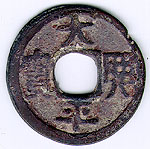 |
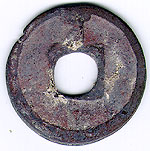 |
|
Thien Phuc Tran Bao
This coin was minted between 980 and 1010. The example here is a little
beat at the rim but the back character shows nicely. The Le character
on the back is the name of the short lived Le Dynasty of 981-1010.
24.1mm x 0.9mm
VÁó@wêt
|
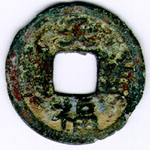 |
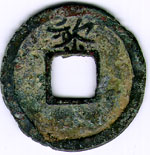 |
|
Thien Phuc Tran Bao
This coin was minted between 980 and 1010. The example here is unfortunately
very worn so the characters are difficult to see.
23.5mm x1mm
VÁó@wêt
|
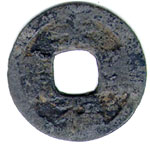 |
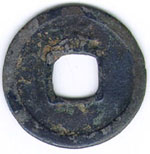 |
|
Dien Ninh Thong Bao
This coin was minted from 1454-1458 by the 4th king of the Le dynasty
(1428-1785). Like most 15th and 16th century Le coins, it is generally
a beautifully made coin with crisp calligraphy. It is also quite common
and easy to get hold of an example.
24.5 mm x 1.2 mm
JÊó
|
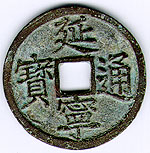 |
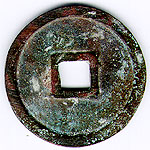 |
|
Thien Hung Thong Bao
This coin was minted only in1459 and is rather uncommon. As with other
coins of this era the coin is crisp and the characters are deep.
24mm x 1.1mm
V»Êó
|
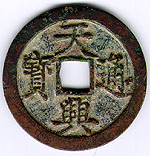 |
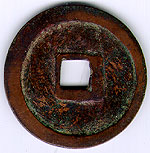 |
|
Hong Duc Thong Bao
This coin was minted1470-1497. It was given to me a good coin collector
friend. I am rather sure that it is a mother coin because it is of extremely
fine make, the character and rim edges are vertical and deep, and the
coin is slightly larger than the rubbing in my source text the Touyou
kosen zuroku (Anasendou 1977). It is no larger on the outside than
the similar circulating coin below, but measuring across the inside of
the rim it is slightly larger. The metal seems to have a high nickel content.
25mmx1.2mm
^¿Êó@µË^¿
êK
|
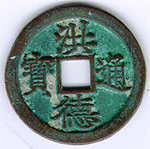 |
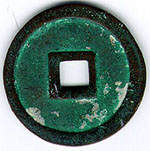
|
|
Hong Duc Thong Bao
This coin was minted1470-1497 and is a circulating coin minted from a
mother coin such as the one above.
25mmx1.1mm
^¿Êó@µË^¿
|
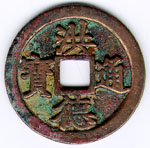 |
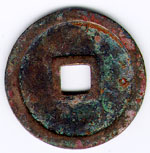 |
|
Canh Thong Thong Bao
This coin was minted 1498-1503. It was given to me by a good coin collector
friend. It has suffered some damage but it may be a mother coin because
it is of extremely fine make, the character and rim edges are vertical
and deep, and the coin is slightly larger than the rubbing in my source
text. The metal seems to contain more copper than the Hong Duc Thong Bao.
However coins of this era in Annam are generally of extraordinarily fine
make.
24.5mm x1.1mm
iÊó@µË
êK ©H
|
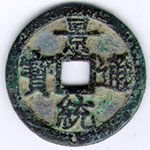 |
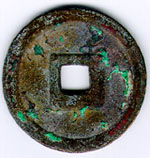 |
|
Thoai KhanhThong Bao
This coin was minted from 1505-1509. It is uncommon. This coin is very
thick.
25 mm x 1.8 mm
[cÊó
êK ©H
|
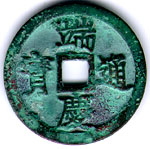 |
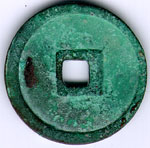 |
|
Chanh Dai Thong Bao
This coin was minted from 1530-1540 and is rather uncommon. This version
is the "small character, small hole" variety, and the coin itself
is rather small. I like this coin because like many other Annam coins,
by chance, it has a name like a Japanese era name.
22 mm x 1.4 mm
å³Êó
¬·ú
|
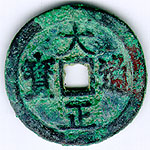 |
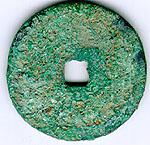 |
|
Nguyen Hoa Thong Bao
This coin was minted 1533-1548. I like the quirky style of the characters.
I also like this coin because it has the same legend as a Japanese coin
from 1617, the rare Genna Tsuuhou. This coin itself is uncommon.
24 mm x 1 mm
³aÊó@Ù§
|
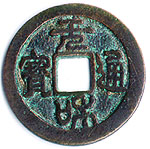 |
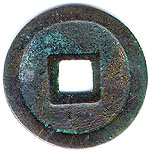 |
|
Nguyen Hoa Thong Bao
This is another example of the coin above. It has apparently been dug
up and is covered in a fine sand. The colors are just like the sandstone
back at the home of my youth in West Virginia.
24 mm x 1 mm
³aÊó@Ù§
|
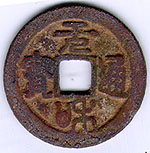 |
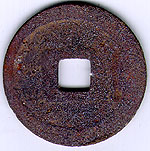 |
|
Thai Binh Thong Bao, reverse star
This coin was minted from 1737, more or less at the same time as the
Canh Hung Thong Bao below. This one has a single star on the back above
the hole.
24 mm x 1 mm
¾½Êó@w¯
|
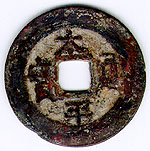 |
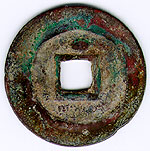 |
|
Thai Binh Thong Bao, reverse "ichi so"
This coin was minted from 1737, more or less at the same time as the
Canh Hung Thong Bao below. This coin has markings on the back which are
not exactly like what I can find in the catalogues, but coins are filled
with variety in this era in Vietnam. On the back of this coin at the top
is the character for "one" and on the bottom an arrow shape
not too unlike the recognized variety (in Japanese: hai so) of a left
dot over a diagonal line. Maybe this is that type.
23.5 mm x 1 mm
¾½Êó@wê\@itHj
|
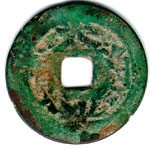 |
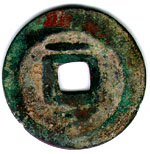 |
|
Canh Hung Thong Bao, reverse "Kinh"
This coin was minted 1740-1776 and has more basic variants than any other
Annam royal issue. Many of the variants substitute other words for "circulating
cash" "thongbao." These include words which mean "important
cash," "large cash," "giant cash," "eternal
cash," "true cash," "central cash," "inner
cash," "spring of cash," "fat cash," and "the
ultimate in cash." It certainly is the ultimate in cash. There are
so many that I have put some examples on a separate page for Canh
Hung coins.
24 mm x 1 mm
i»Êó w
|
@
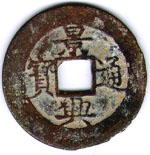
|
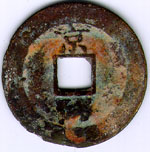 |
|
Canh Hung Thuan Bao
This "orderly cash" looks like one of the Canh Hung variants
but is listed as a subsequent coin minted from 1776-1787.
i»ó
|
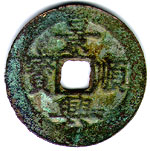 |
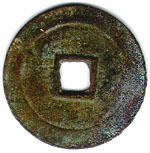 |
|
Chieu Thong Thong Bao
This coin was minted in 1787. It has quite a few versions with different
characters on the reverse side.
24 mm x 1 mm
ºÊó
|
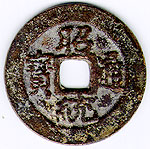 |
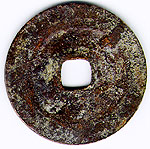 |
|
Chieu Thong Thong Bao, reverse Chanh
This coin was minted in 1787. This version has the character Chanh on
the reverse side, which refers to the upper provinces of Tunquin.
25 mm x 1 mm
ºÊó w³@
|
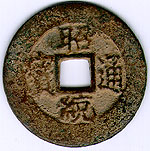 |
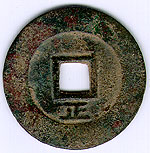 |
|
Chieu Thong Thong Bao, reverse Trung on top
This coin was minted in 1787. This version has the character Trung on
the reverse side, which refers to the province of Thanh-hoa. This coin
is more uncommon than the one with Trungplaced under the hole.
25 mm x 1 mm
ºÊó wã
|
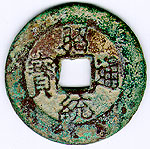 |
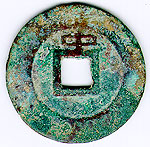 |
|
This coin was minted from 1788-1792. It has many different varieties
of reverse side markings. This one here is plain which is common, but
has a very thick outer rim which is less common.
22.2 mm x 0.8 mm
õÊó@
|
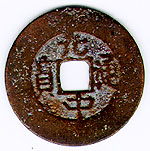 |
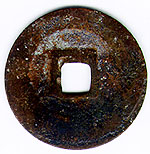 |
|
Canh Thinh Thong Bao
This coin was issued 1793-1800. This variant has four octagons on the
reverse. I bought this in a coin fair in Santa Barbara. The coin holder
had a notation which says"'Water lily money' given to Buddhist temples,
ex. Rev. Harris collection"
23mmx.7mm
i·Êó@wlÍN
|
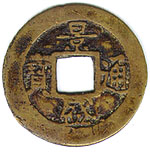 |
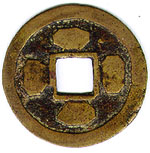 |
|
Than Thai Thong Bao, reverse Tap Van
This coin was issued in 1889-1906. This version with "10 wen"
written on the back is quite common.
¬×Êó@w\¶
|
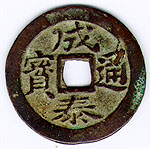 |
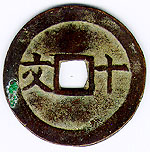 |
|
Duy Tan Thong Bao, reverse Tap Van
This coin was issued 1907-1915. The name of this coin means "renovation"
It is read Ishin in Japanese and may be a reference to copy the success
of Japan's Meiji Restoration, the Meiji Ishin.
ÛVÊó@@w\¶
|
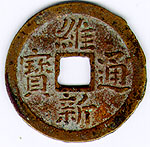 |
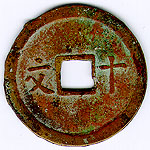 |
